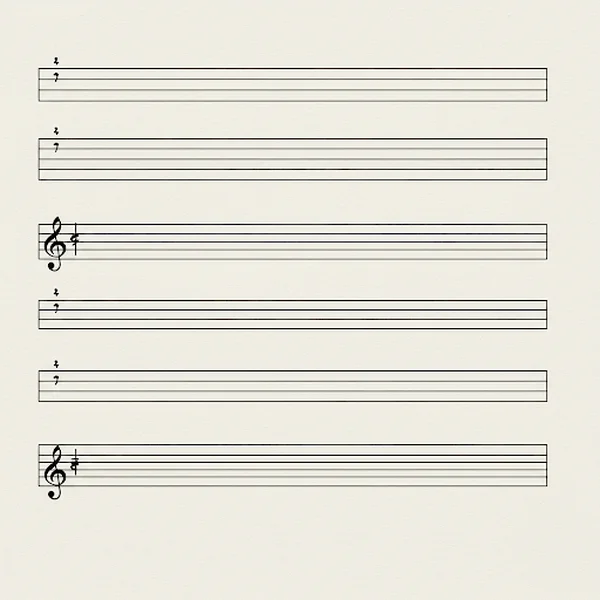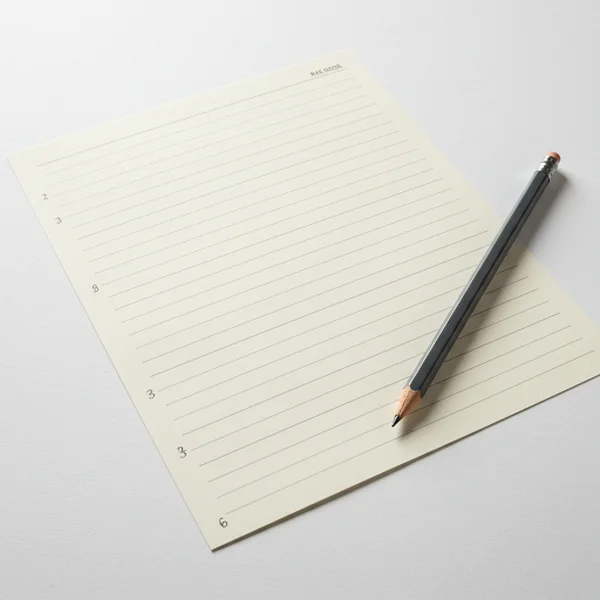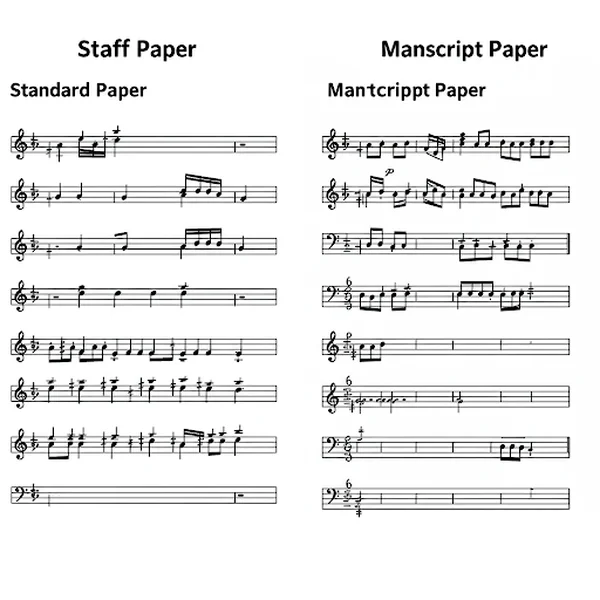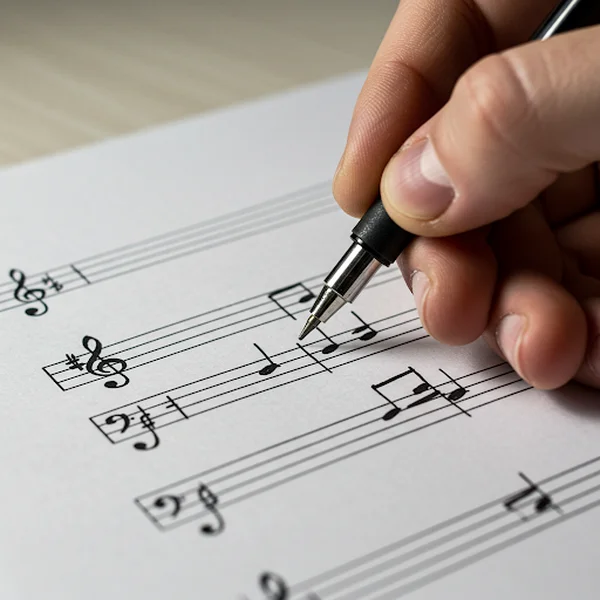Staff Paper vs Manuscript Paper: Choose the Right One
Ever stared at options for blank music sheets, wondering about the difference between staff paper and manuscript paper? What paper is used for music composition versus final scores? It's a common question for musicians, students, and composers alike. This guide will clear up the confusion, explaining the distinct roles of each type so you can choose the best fit for your needs. Ready to find the perfect printable paper? Discover high-quality options on our site.
What Exactly is Staff Paper? The Standard for Notation
What is staff paper called by musicians? Simply put, staff paper is the backbone of standard Western music notation paper. It features pre-printed staves – the sets of five horizontal lines and four spaces where musical notes are written. How to choose music paper often starts with understanding this fundamental format.

The Anatomy: Lines, Spaces, and Staves
The consistent layout of staff paper, often with 10 or 12 staves per page, is designed for clear and unambiguous reading. This standardized format using precise notation sheets makes it ideal for finalized pieces meant to be read and performed by others. Think of it as the formal document for your musical ideas, utilizing standard stave paper conventions for ultimate clarity.
Designed for Final Scores and Music Reading
Because clarity is paramount, traditional staff paper is the go-to for creating final scores, parts for ensemble players, educational exercises, and anything that requires universally understood music notation. If legibility for performance or study is your goal, standard staff paper is usually the best choice.
Defining Manuscript Paper: The Composer's Canvas
So, what kind of paper do composers use when sketching initial ideas? Often, it's manuscript paper. While it also features staves, the term typically refers to paper that might offer more flexibility, sometimes with more staves per page or even just blank pages with widely spaced staves (blank stave format) for rough work during music composition.

Understanding Systems and Stave Counts
Manuscript paper can vary greatly. Some styles resemble standard staff paper, while others might have 16, 24, or more staves squeezed onto a page, ideal for orchestral sketches or lead sheets where seeing many parts at once is helpful. The focus is less on pristine presentation and more on capturing the flow of arranging music or composing.
Ideal for Sketching Ideas and Early Drafts
Think of manuscript paper as the musician's sketchbook. It's perfect for jotting down melodies, experimenting with harmonies, working out complex rhythms, or any stage where ideas are still evolving and neatness isn't the primary concern. Can I use staff paper for composing? Yes, but many find manuscript paper feels less restrictive for those initial, sometimes messy, creative bursts.
Key Differences: Spotting the Music Paper Difference
What is the difference between staff paper and manuscript paper fundamentally? While both are types of blank music paper used for writing music, their intended design and typical usage create key distinctions. Let's break down the main music paper difference so you can confidently select the right type.

Layout Comparison: Stave Spacing and Density
Standard staff paper usually prioritizes readability with comfortable spacing between lines and staves, making the final sheet music paper easy to follow. Manuscript paper, especially styles meant for sketching by composers, might feature more staves per page (higher density) or wider spacing between staves to allow for annotations, lyrics, or chord symbols. You'll find various layouts when searching for empty music paper.
Pre-Printed Elements: Clefs, Bar Lines, or Blank?
Traditional staff paper often comes completely blank beyond the staves, offering maximum flexibility for adding clefs, key signatures, and time signatures yourself. While some variations exist, manuscript paper also typically provides a blank canvas, emphasizing its role in the drafting stage rather than presenting a finished piece.
Intended Use: Polished Notation vs. Creative Freedom
This is the core difference: Staff paper is generally geared towards producing clear, final, or easily readable music notation suitable for performance or formal study. Manuscript paper leans towards the creative process – drafting, sketching, arranging – where flexibility and space for experimentation are often more important than perfect presentation found in typical music score paper.
When to Use Staff Paper: For Clarity and Performance
When should you definitely reach for standard staff paper? Choose it when clarity, legibility, and adherence to notational standards are key priorities. Where can I get blank music paper suitable for these tasks?

Writing Legible Sheet Music for Others
If you're preparing a piece for another musician to read or perform, standard staff paper ensures your writing music is clear and follows conventions they'll easily understand.
Standard Music Education Exercises
For students learning notation or completing theory assignments, using standard staff paper (like the readily available music practice paper formats) reinforces correct notation habits and makes grading easier for teachers.
Finalizing Arrangements and Parts
When your composition or arrangement is finalized, transferring it neatly onto staff paper creates the definitive version for performance, publication, or archiving.
When Manuscript Paper Shines: Sketching and Flexibility
And when is manuscript paper the better choice? Opt for it during the creative, less formal stages, or when standard layouts feel too restrictive. Is manuscript paper the same as staff paper? No, and its flexibility is often why composers reach for it initially.
Brainstorming Melodies and Harmonies
When ideas are just flowing, manuscript paper provides the space to quickly jot down fragments, experiment with chords, and not worry about perfect note spacing or alignment.
Working Out Complex Arrangements
For intricate orchestral scores or complex layered parts, the potentially higher stave density or different layouts of some manuscript paper can be advantageous for seeing the bigger picture of the arrangement as it develops.
Need for Custom Notation or Spacing
If you need extra room between staves for lyrics, extensive annotations, chord diagrams, or perhaps non-standard graphical notation, the less rigid format sometimes found in manuscript paper can be ideal.
Staff Paper or Manuscript Paper: Making the Right Choice for Your Music
Understanding the distinction between staff paper and manuscript paper empowers you to select the right tool for the job. Staff paper excels in clarity for finished work and standard practice, while manuscript paper offers flexibility for the creative process and sketching. The key music paper difference lies in their intended primary use and resulting layout emphasis.
Ultimately, the best choice depends on your specific task. Need a clean, standard format for your final piece or practice exercises? Standard staff paper is likely your answer. Exploring new musical ideas or drafting complex arrangements where space and flexibility are key? Manuscript paper might serve you better.
Ready to get started with clear, high-quality paper? Find a wide variety of free printable staff paper formats perfectly suited for standard notation, practice, and teaching right here on our website.
Staff Paper vs Manuscript Paper: Frequently Asked Questions
Is manuscript paper the same as staff paper?
No, they are not strictly the same, although both feature musical staves. Standard staff paper usually implies a format optimized for clarity and final notation, while manuscript paper can refer to a broader range of layouts, often favoring the sketching and drafting process where flexibility might be prioritized over standardized appearance.
Can I use staff paper for composing drafts?
Absolutely! Many composers use standard staff paper for drafting. It works perfectly well. However, if you prefer more staves per page for complex ideas or need extra space between staves for notes and sketches, specific manuscript paper formats might feel less constraining during the initial creative stages.
What kind of paper do professional composers use?
Professionals typically use both! They might use manuscript paper (whether digital or physical) for initial sketches, developing ideas, and working out complex sections. Then, they often use standard staff paper (or notation software outputting a similar format) for creating polished, final scores and parts intended for performers to read easily.
Where can I get blank music paper for free?
You're in the right place! Our site offers a fantastic selection of free printable staff paper in various standard formats. Whether you need basic blank staves, piano grand staff, or other layouts, you can easily download high-quality PDF files ready for printing. Check out the options available now!